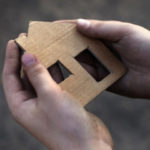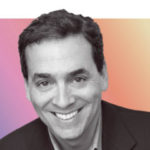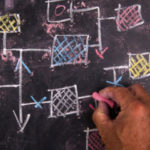Once you start to look, they’re everywhere: meeting professionals who work — or have worked — as actors, performance artists, or production designers for theater, movies, and television. When you think about it, it’s not surprising. The meetings industry shares not only some of the same stages and venues with theater productions, but also basic tools, such as light and sound.
But in recent years, the two domains — meetings and performing arts — have begun to look less like parallel worlds and more like intersecting spheres. Meeting planners talk about the structure of their events in terms of story lines and dramatic arcs, and consult with producers to make sure not just that their presentations are seen and heard, but that audiences are emotionally engaged by them. And more and more actors and performance artists are finding themselves in the spotlight at meetings, not as the entertainment brought in during lunch, but as meeting designers, master storytellers, and learning facilitators.
“At the end of the day, it is really all about engaging an audience,” said Jordan McArthur, content marketing manager for Guidebook Inc., which creates mobile apps and guides for meetings and events, as well as an actor, producer, and writer for the web series “The Digressions.” “When I was working in the theater, it was all about the audience,” said McArthur, who also performed for two seasons at San Diego’s Old Globe Shakespeare Theater Festival. “The focus is on how are we going to leave these people different from when they enter the building to when they leave the building.”
STARRING: EMOTION AND ACTION
Probably chief among the reasons that the dramatic arts are so relevant and useful to meetings is that, as McArthur points out, people in the theater have spent centuries devising and perfecting ways to keep audiences engaged. “Since engagement is such a huge thing for us [in the meetings world],” he said, “why would we not look to theater to see what they are doing in that arena?”
Dramaturgy — an academic term that refers to dramatic theory and structure — also can be described as the “science of keeping people’s attention,” said Bo Krüger, a Danish expert on meeting design and innovation who has a master’s degree in education — and is also a comedian and improvisational actor. One of the co-designers of “Meetovation,” a systematic meeting-design concept adopted by Visit Denmark, Krüger, who has worked at the Danish Institute of Technology, applies notions about the interplay between emotion, attention, and learning taken from the fields of psychology and neuroscience to his work as a meeting designer and facilitator, as well as the tips and tricks that Hollywood uses to create blockbuster movies.
Attention is a key component in learning, but so is emotion — it’s “one of the ways you lock in learning,” said Roger Haskett, a Vancouver-based actor and the CEO and artistic director of Engagement Unlimited, whose services include meeting design, entertainment, and “conference weaving.” “If you can build in an emotional arc to an event, an experience, a meeting, or a conference,” Haskett said, “who’s not going to talk about that conference?”
If you can build in an emotional arc to an event, an experience, a meeting, or a conference,” Haskett said, “who’s not going to talk about that conference?
Another place where meeting organizers can learn from theater is in the ability to tell stories. “We live in the world of stories — it is the building block of human society,” said Haskett, who earned a bachelor of fine arts in acting and a master’s degree in education from the University of British Columbia. “Eighty percent of the way we talk on a daily basis is through narrative. And so stories should be one of the core components of any conference or meeting.” A meeting “should have a story, and it should be presented with a beginning, middle, and end — with complications, and conflict that raise the stakes, that get people involved and excited.”
For example, the 2014 Sustainable Meetings Conference, organized by the Green Meeting Industry Council (GMIC), used bridge-building — between individuals and organizations, and ideas and strategies — as a central metaphor. The conference agenda, which was hand-printed on a “bridge” that physically stretched across the ballroom carpet, took attendees through a series of interactive exercises that culminated in the construction of another “bridge,” this one built of cardboard boxes. The boxes were labeled with strategies and steps, generated by groups of participants, that were expected to lead toward more sustainability in the meetings industry.
Actors and storytellers also intuitively understand that conflict is part of what makes stories satisfying, and that the most authentic characters are a blend of positive and negative traits. Krüger uses psychologist Barbara Fredrickson’s recommended three-to-one “positivity ratio” to help create meeting environments that allow attendees to flourish but don’t banish discomfort. “What I’m striving towards in meetings is to have at least three times as many positive emotions as negative — but not to get rid of the negative,” Krüger said. “Negative emotions are important, because they add drama, motivation, and energy to the meeting. It’s human to have negative emotions, and we must never ban them. I don’t think learning, change, and engagement is possible without some anxiety and negative emotions.”

When Krüger and Ann Hansen, who collaborated with Krüger to design Meetovation, recently led a small meeting-design workshop for planners at the Bella Center in Copenhagen, participants were nonplussed to arrive in the morning to a room where a pile of chairs, ottomans, and an assortment of tables were stacked haphazardly in the middle of the space. The group, divided into teams and guided by some basic suggestions, spent the first 20 minutes of the two-day workshop setting up the room in ways that felt most comfortable to them. It was a demanding, even anxiety-producing, start to the day for participants, who were asked to negotiate ideas and move furniture with other attendees, most of whom they didn’t yet know. But the result was a meeting environment in which participants felt ownership and were emotionally invested.
The performing arts are no stranger to that sort of hands-on engagement. Despite the contemporary image of theater as one-way communication — the action is on the stage, with theatergoers as passive consumers — historically, theatrical productions were interactive. “In Elizabethan times,” McArthur said, “you had what were called the ‘groundlings.’” They stood near the stage for the entire performance, McArthur said. Actors played to the groundlings “because they were the fun ones.… They were throwing things on the stage. They were yelling. They were booing. They were hissing. They were cheering and crying. It was a total free-for-all, and somewhere along the way, we got polite.”
That kind of emotionally arousing environment, it turns out, is optimal for learning, according to Haskett. “Active learning and participatory models increase retention and understanding of what you’re trying to communicate,” he said. “I really believe in rambunctious, disruptive rooms. I believe education is both a product of focus and discipline, which everyone understands, but what most people don’t understand is that learning is also equally about disruptive energy. It’s about energy being created by new ideas that are created in your mind, which then inhabit your body.”
‘A BLUR OF EXCITEMENT’
Haskett didn’t set out to be “an event guy,” he said. But once he finished theater school and saw that no one was in a hurry to give him acting jobs, he started a company where he could do the kind of performing he most enjoyed. What he was really interested in, he said, was getting in front of people and interacting with them — “which meant that I was going further and further into the event world. I love breaking down barriers. I’m not very comfortable being on stage doing a show where there’s a fourth wall and where the only people you’re ever supposed to interact with are the people on the stage with you.”
Looking back, Haskett was a bit ahead of his time. In the ’90s, “interactivity was actually sort of a bad word,” he said. “People sort of ran away from anything that was interactive.” But he kept at it, working as a film actor as a day job and running his company on the side, because “this is what I love doing.”
In the ’90s, interactivity was actually sort of a bad word.
His performing career thrived — he taught acting and appeared in more than 150 commercials, TV shows, and movies. But over time, he noticed that his event company, which he “basically ran out of my back pocket,” kept growing and flourishing. Six years ago, Haskett made a decision to switch his focus and concentrate on the company, adding additional employees and services. Since then, his professional life has been “a blur of excitement.” And he’s noticed that his company has become increasingly central to the event-planning process for his clients. He often is brought in, not as a third-party adjunct, “but at the very beginning of a project, to be part of the design team.”
Haskett is betting that the future of the meetings industry will include more artists — not just actors but visual artists. “I don’t mean artists as in on a stage, doing something interesting and then leaving the stage. We’ve had that all along. That’s great and that’s going to continue,” Haskett said. “What I’m talking about is artists in the design element of meetings — artists who are sitting around the table when a meeting is first being discussed. Artists are emotional; they’re able to capture a much larger idea or experience and bring it down to an understandable and identifiable story.”

CREATIVE CLASS
Haskett could be talking about Debra Roth, a principal and creative designer at New York City–based The Originators design company, which is well known in the special-events world for creating innovative stretch-fabric structures and stage elements. Roth’s work has been featured everywhere from corporate events to the Super Bowl, but Roth began her career as a performance artist and sculptor in Boston, where she and other artists would build the gallery environments where they then would perform. Over time, she began to specialize in fabricating structures, but she hasn’t left the performance aspect of her work behind. “The stuff we work on is fast, it’s furious, it’s fun, it’s colorful,” Roth said. “It’s alive.”
A recent Originators design — a curving, coral-toned structure that mimicked the spiraling inside of a conch shell — was for a popup shop in New York City that created immersive environments matched to a new line of air-freshener scents. Such environments create experiences that can surprise and delight. “It’s all very different,” Roth said, “which makes it really fun.”

Event planners don’t always take advantage of opportunities to create different kinds of experiences for their attendees, she said. They might fear that it’s too expensive or complicated, but it can be as simple as constructing a big fabric tunnel to travel through from the street into the venue. In the tunnel you can add sound or project images, or both. “As people are walking in, it affects them,” Roth said. “They like it, and the next thing you know, they are taking pictures and posting them” to social media.
And talking to each other. Creating different kinds of environments also can create new ways for attendees to connect. “You don’t always need to meet people over drinks to say, ‘Hi, I’m so-and-so and this is what I do.’ You now have this little experience together,” Roth said. “If you’ve done that, let’s say at the beginning of the conference, some kind of icebreaker, during the whole rest of the conference when you see that person, you have an immediate connection.”
DRAMATIC ROI
Artistic expression, however satisfying, isn’t the driving force behind the intentional use of things like emotion, narrative, and surprise at meetings — it’s ROI, Haskett said. Today’s business climate demands that meeting designers clearly establish ROI, and “I am all for that,” he said. “I could not be happier that people are starting to demand ROI. And to me that is where artists come in — they already know how to affect people on a large scale,” Haskett added. “The old model — where people come to sit in a darkened room and absorb wisdom from someone on stage who talks at you — doesn’t work anymore.”
“Theater really evolved out of a basic human need, which was to entertain in a way but also engage in the culture of the community,” McArthur said. “And we talk a lot these days in business and meetings about company culture. And we’re really just playing into that basic human need again, which is we need to feel like we belong somewhere. And the more we feel like we belong somewhere, the more likely we are to work for the good of the community.
“Back when people were performing around the campfire as cavemen, they were learning what is important to the community. And is that not what a meeting is all about?”
6 STEPS TO MORE DRAMATIC MEETINGS
Why shouldn’t your meeting use some of the same tools that Hollywood employs to create blockbusters? asks Bo Krüger, a Danish actor and meeting designer. Krüger suggests six ways to add drama to your meetings:
1. Create a storyline. A storyline is a thread running through the whole meeting. It can be a theme, a metaphor, or a task that has to be solved (for example, making a strategy or an action plan).
2. Create a hook. In any movie or good story, there is a conflict between what the hero desperately wants and how things really are. The rest of the story is about solving that conflict. The conflict, usually present in the beginning of the story, is called the “hook” because its purpose is to catch your attention and make you curious to see what happens next. Translated into a meeting context, this involves starting the meeting by presenting the big question to be solved or the discrepancy between what we really want and where we are now.
3. Create turning points. In a Hollywood blockbuster, the story has different turning points, where the story takes new directions. In a screenplay, you have at least three turning points (one of them called the “point of no return”). Meeting designers should change the format of the meeting at least three times.
4. Create surprises. Have you ever seen a movie where you always can predict what happens? It sucks, and you will probably leave before the end. Likewise, most meetings are way too predictable. (Up next: yet another PowerPoint.) Avoid that by creating positive surprises that break the patterns or go against expectations. Good experiences are usually those that positively exceed our expectations. It’s difficult to exceed participants’ expectations by giving them better food than last time or by having a better speaker. It’s much easier (and less expensive) to give the participants something meaningful, but different and unexpected.
5. Create a climax. Make everything come together at the end. Reintroduce the big question or the main conflict, and present the solution (if it exists) that has occurred during the meeting. Find a creative way to summarize what has been going on during the whole meeting.
6. Create a happy ending. From psychology we know that the final experience colors the whole experience. A bad ending can give an overall bad impression of a meeting that was actually good. Make sure the participant leaves the meeting with a good final experience. The best happy endings are shared by all — for example, a song, an energizer, a non-competitive game, standing ovations, etc.
Test Time
The Certified Meeting Professional (CMP) is a registered trademark of the Convention Industry Council.





